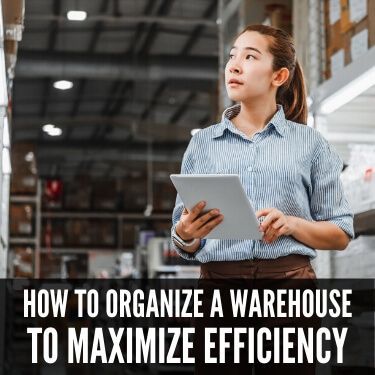
 Copy URL to Clipboard
Copy URL to Clipboard
You have products to ship and store, and now need to know how to organize a warehouse — either because you plan on running one yourself or you plan to store your items with a third-party logistics company and are curious about the inner workings of such an operation.
Thankfully, becoming an expert is within your grasp. You or the logistics company will have to comply with the Occupational Safety and Health Administration’s (OSHA) safety guidelines, but the structuring of a warehouse for efficiency shouldn’t be burdensome to learn and execute. Read below for the best practices to help your business and learn how to organize a warehouse.
Table of Contents
This is ground zero for setting yourself up for success and there’s several aspects you want to heavily consider when first building out your warehouse floorplan
Space: The first thing you should think about is how much space you need and then how much space you can afford. When looking at the amount of space you require, it’s not just the actual warehouse space for the inventory you have to look at. Things like office space within the warehouse, places to store empty pallets and loading areas have to be factored into the equation.
Also, because most equipment in a warehouse is movable, you can set up a plan that is perfect for the start but as your business needs evolve, the vertical racks and shelving is easily able to be rearranged. So while it is important to put some real thought into the initial layout, treat it like Legos — if it’s not working, it can always be built a different way.
Flow: This is essential in order to maximize productivity inside the warehouse and also minimize logjams or — worse — accidents. You want movement to be fluid and uninterrupted as employees move around the warehouse.
Many warehouses have rules instituted like traffic on the road. Most warehouse aisles are one-way movement, you have to stop and look before going across an “intersection” and use horns and/or mirrors on forklifts or other vehicles to make sure you aren’t driving into a dangerous situation.
The warehouse should also be laid out in a logical manner so that workers can move quickly and freely from item to item, especially if you’re implementing a pick and pack system.
Accessibility: This one is kind of a no-brainer but still needs to be mentioned. In the warehouse, the products have to be able to be easily reached without moving other items out of the way or having to step or move around other pallets.
Furthermore, if the items in question are palletized, those need to be able to be accessed by pallet jacks, forklifts and employees. Pallets should also be arranged or stacked in a way where each one that is meant to be reached can easily be reached with no interference.

The first thing that should be thought of in terms of organizing warehouse inventory is safety. There shouldn’t be a situation where you question if something is safe and pick convenience or ease of use over a potentially dangerous situation.
In fact, you should never have to sacrifice safety for efficiency and should organize your warehouse according to OSHA safety guidelines. If things are set up with a mind to keep workers safe and they know that, they can move faster without having to worry each minute about confronting an unsafe moment just around a corner.
The warehouse should also be organized so it can be easily kept clean — this goes for the floors and the shelves. If dangling shrink wrap from pallets or debris on the floor is left, it will either slow down workers or leave the potential for workplace injuries.
As far as the inventory itself, it is ok to have some extra items stocked out on the floor but putting everything in the building out might make it tougher to organize and access, which will cut down on efficiency.
You should also track inventory using an Inventory Management System (IMS), which will help keep your inventory count up to date and help the flow of organization because you can restock items before they’re completely out.
To manage a warehouse effectively, you’re going to hear some aspects that appeared in the previous section How to Make a Warehouse Floorplan.
That’s because one of the first things to do is plan your warehouse space well and arrange it appropriately. Your business should also be able to adapt the warehouse space to any changes your changing needs dictate. And sometimes, some forethought is good to have, so you can also anticipate implementing changes before you are suddenly forced to.
Establishing protocols for safety procedures is a smart practice so there is no grey area on what goes while moving about the warehouse. Training staff on both safety and general warehouse rules is also a good measure to take.

If you can find a trusted third-party logistics company to handle your warehousing needs, that could really maximize efficiency for your business.
All you’d have to do is verbalize or write down what you need and the rest would be handled by the logistics people. They would come pick up your products, store them in their warehouses and even fulfill orders for you.
The logistics company can employ a variety of different inventory management systems or pick and pack systems, like the FIFO procedure.
The best part is you don’t have to invest a lot of time and money getting everything set up or learn the ins and outs of warehousing to see your business thrive. You can find cost-effective options with reputable companies that will lighten the load for your operation.
Once you are confident that you know about the ins and outs of how to maximize efficiency in the setup of a warehouse, it’s time to find out how R+L Global Logistics can help your business reach its storage and fulfillment goals.
With buildings full of storage available both domestically and internationally, R+L Global Logistics knows how to organize a warehouse and also offer stellar fulfillment options through our pick and pack systems in place.
R+L Global Logistics offers everything you’d need in the supply chain: we can come pick up your goods from your factory — or from the place you purchased them from if you’re a wholesaler — store them in our warehouses and then fulfill orders to your customer, all in a cost-effective efficiency aimed at helping out your bottom line. We have the help you need, even with items such as packaging inserts.
When transporting your goods, we have real time freight visibility and a network of competent drivers to get your order to its final destination as soon as possible. Should the need for guidance or to answer any questions arise, our responsive customer service team is readily available.
To get started today with R+L Global Logistics, visit our website for a free, no-strings-attached quote or call us at 866-989-3082 to find out about the R+L difference.
